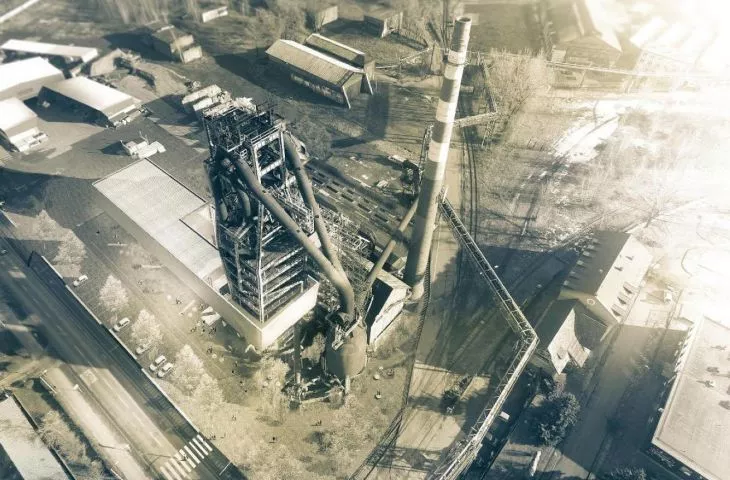What to protect in Silesia as it is, what to creatively transform and what to give up to make room for the new, we recently debated with the community of local architects at the Silesian Museum in Katowice[report]. Many of the post-industrial sites are currently in a very poor state of repair, such as the Szombierki Combined Heat and Power Plant in Bytom, which has been included in the Europa Nostra list as one of the most endangered European Heritage 2020 sites, for the protection or change of function of others lacks ideas, or funds. Hope for a change in this state of affairs was given by the recently resolved competition organized by the City of Ruda Śląska, whose goal was to revitalize the blast furnace of the "Room" steelworks and create a unique, vibrant post-industrial space that will become a landmark of Ruda Śląska.
Built in 1968, the Great Furnace of the "Room" Steelworks in Ruda Śląska was entered in the register of monuments at the end of 2012 by a decision of the Silesian Provincial Conservator of Monuments in Katowice. The city, which took over this historic building in 2018, announced an international implementation competition for the development of an urban-architecturalconcept for the revitalization and adaptation of the building for tourist and culturalpurposes.
The competition jury, chaired by Lukasz Urbańczyk, the Municipal Conservator of Monuments, awarded as many as five prizes and four honorable mentions. Congratulations!
1st prize
eM4 Pracownia Architektury Brataniec
1st prize, proj.: eM4 Pracownia Architektury Brataniec
© eM4 Pracownia Architektury Brataniec
The first prize was awarded for the synthetic and clear concept of displaying the unique qualities of the post-industrial Blast Furnace complex. The simple, horizontal mass, referring to the traces of the funnel hall, housing the entrance complex to the museum, emphasizes the complexity of the vertical industrial elements, accentuating their pragmatic history, as well as the peculiar romanticism of their presence. The public space obtained by placing the entrance block as suspended above the site is independent of weather conditions. The Competition Jury positively evaluates the proposal to use the railroad overpass for complementary office functions. The simplicity of the solution makes it possible to implement it within the assumed budget. The idea of shaping greenery in the spatial establishment as natural succession and migration of plants was also appreciated.
2nd prize
Group 5 Architects
2nd prize, proj.: Grupa 5 Architekci
© Group 5 Architects
The second prize was awarded for an impressive and coherent vision of shaping the urban space of the establishment and its architectural form, as well as a precise program of exposition in both the program and spatial layers. The possibility of realization of the proposed functional program within the assumed budget of the investment is questionable, as well as the reality of the shaped underground function without discerning the actual shape of the existing foundations.
3rd prize
BDR Architects
3rd prize, design: BDR Architekci
© BDR Architects
The third prize was awarded for a restrained and realistic concept that is feasible within the foreseen investment budget, as well as a well-thought-out idea of the museum exhibition. At the same time, the Competition Jury's significant doubt was raised by the inexpressive nature of the proposed architecture.
4th prize
8486 Architekci Henryk Struski
4th prize, proj.: 8486 Architekci Henryk Struski
© 8486 Architects Henryk Struski
The fourth prize was awarded for the urbanistic qualities of shaping the city square and the atrial spatial layout of the building. Doubts are raised by the use of two underground floors and the resulting, anticipated significant investment costs.
5th prize
ARSIS Atelier Projektowe
5th prize, design: ARSIS Atelier Projektowe
© ARSIS Atelier Projektowe
The fifth prize was awarded for the proper spatial disposition of the set program, freeing the city square in the foreground of the blast furnace complex and attempting to shape a light and ephemeral architecture of the new facilities. Doubts were raised about the excessive dismemberment of the functional program and too much interference of the new buildings with the preserved substance of the post-industrial facilities.
Honorable mentions
Super Future Group
Honorable mention was awarded for the attempt to create a centripetally oriented public space in the newly designed facilities (Museum Square) and the attempt to integrate architecture with greenery (Secret Garden).
Honorable mention, proj.: Super Future Group
© Super Future Group
VOBOO Mateusz Okrajni
Honorable Mention was awarded for the attempt to place most of the museum rooms underground and molding the entrance elements.
Honorable mention, proj.: VOBOO Mateusz Okrajni
© VOBOO Mateusz Okrajni
WXCA
Honorable Mention was awarded for highlighting the dialogue between nature and the preservation of industrial heritage, and for being part of an innovative take on the issue.
Honorable Mention, proj.: WXCA
© WXCA
JRK72 Architect Jacek Krych
Honorable Mention was awarded for an expressive and consistent attempt to create a museum and exhibition space in an interior separated from the external structure of the city.
Honorable Mention, proj.: JRK72 Architect Jacek Krych
© JRK72 Architect Jacek Krych
elaborated. {tag:AuthorAiB}
Illustrations courtesy of the City Hall of Ruda Śląska































































































































































